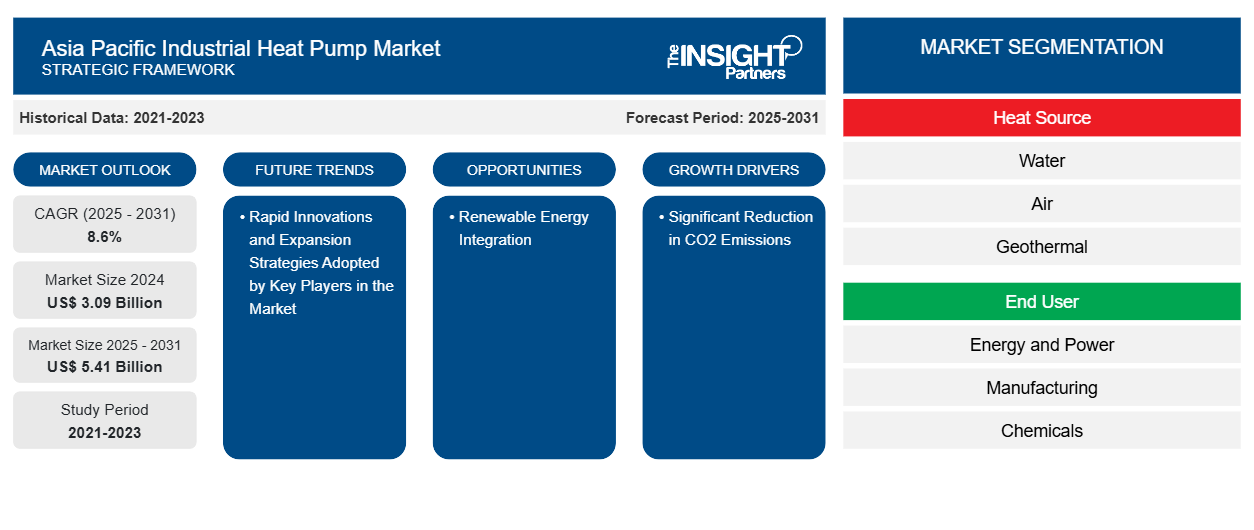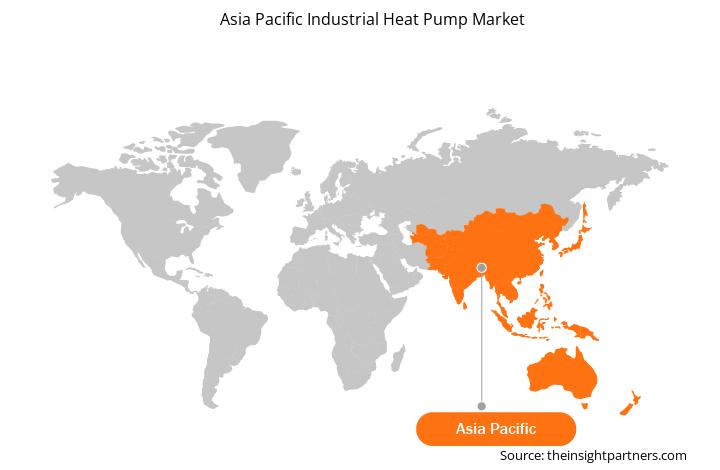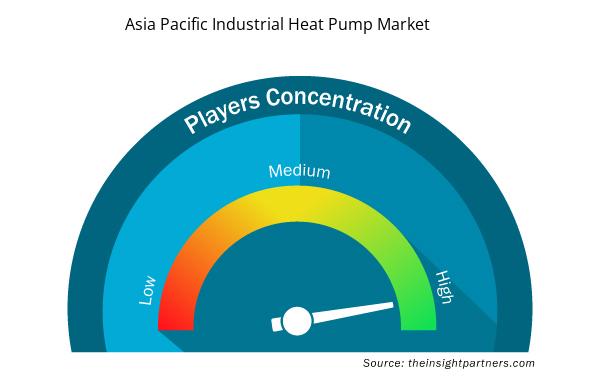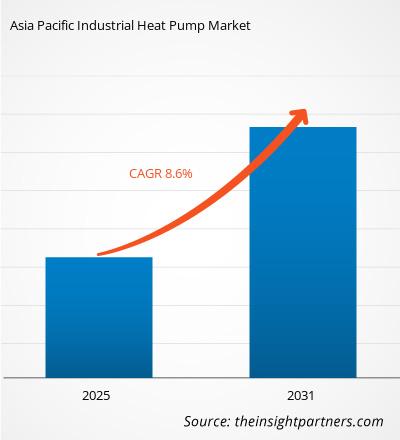亚太地区工业热泵市场规模预计将从 2024 年的 30.9 亿美元增至 2031 年的 54.1 亿美元。预计 2025-2031 年期间,该市场的复合年增长率将达到 8.6%。主要参与者采用的快速创新和扩张战略可能会在未来几年为市场带来新的关键趋势。
亚太工业热泵市场分析
工业热泵在能源和电力、制造业、化学品、食品和饮料、造纸和纸浆以及木制品行业具有潜在的最终用途。其他最终用途行业包括农业、室内种植、纺织、制药、水泥和混凝土加工。人们越来越关注降低环境污染和减少碳足迹,这加速了对工业热泵的需求。这些泵可以潜在地提高能源效率并减少二氧化碳排放。工业热泵可能用于能源和电力部门的发电。工业热泵可以利用波长范围广的太阳能发电,包括光范围和红外范围。高端工业热泵主要用于制造业,因为它们具有能源效率、成本效益和可持续性。化学工业是最耗能的行业之一。使用化石燃料的限制、能源独立的要求以及温室气体排放的环境挑战正在影响工业热泵在化学工业中的应用。
热泵通过切换工作流体的流动方向,在同一系统中提供供暖和空调,表现出显著的多功能性。工业热泵还消除了对双系统以获得所需温度的需求。工业热泵会损失一些效率,在极其恶劣的气候条件下可能需要额外的热源。这种补充热量可以来自电加热器或地热加热的水。工业热泵市场的终端行业包括能源和电力、制造业、化学品、食品和饮料、造纸和纸浆以及木制品。其他终端行业包括农业、室内种植、纺织、制药、水泥和混凝土加工。这些行业需要大量工业热泵来集成到其基础设施中,以实现高效运营。
亚太工业热泵市场概览
亚太地区的工业热泵分为中国、日本、印度、印度尼西亚、韩国、新加坡、澳大利亚和亚太地区其他地区。这些国家的外国直接投资正在增加,以发展工业部门。根据联合国贸易和发展会议的数据,亚太地区发展中国家的外国直接投资达到 6190 亿美元,到 2022 年增长了 19%。此外,发展中国家主要企业对汽车制造业的投资不断增加,对工业热泵的需求也巨大。
例如,2025 年 1 月,中国比亚迪有限公司(电动汽车制造商)计划投资 10 亿美元扩建其在印度尼西亚的工厂。此外,2024 年 11 月,大陆集团计划扩大其在泰国的轮胎制造能力。预计年产能将达到 300 万条轮胎。工业热泵也正在成为汽车制造厂的一项重要技术,为降低能源消耗和提高效率提供了一种可持续的方式。在汽车领域,热泵在温度管理、加热和能量回收方面发挥着重要作用。亚太地区领先汽车制造商不断增强的工业工厂扩建能力推动了市场的增长。亚太工业热泵市场的主要参与者包括美的、申菱、大金、三菱电机和松下公司。
化工、石油、天然气和能源行业的旺盛需求也有利于亚太地区的工业热泵市场。据亚太经济合作组织称,2023 年,全球化学制造业价值 5.7 万亿美元,该地区的收入占比超过 45%。在化学制造厂中,工业热泵作为提高能源效率和减少碳排放的可持续解决方案越来越受到青睐。
许多国家都制定了某些法规来管理碳排放并提高工厂的整体能源效率。日本正在推动实施碳定价机制,例如碳税或限额与交易制度,以鼓励企业减少碳排放。日本积极参与包括《巴黎协定》在内的国际气候框架,以减少碳排放。此外,韩国推出了绿色新政,这是更广泛的经济复苏计划的一部分,旨在促进低碳产业和基础设施发展。政府不断增加的碳减排举措,以及亚太地区日益增长的工业发展,推动了工业热泵市场的增长。
定制此报告以满足您的需求
您可以免费定制任何报告,包括本报告的部分内容、国家级分析、Excel 数据包,以及为初创企业和大学提供优惠和折扣
亚太工业热泵市场:

- 获取此报告的关键市场趋势。这个免费样品将包括数据分析,从市场趋势到估计和预测。
亚太工业热泵市场驱动因素和机遇
对节能解决方案的需求
热泵利用深孔或管道从地面获取热量。它还可以利用下水道或废水等原本会被浪费的热源,从而提高工业热泵的整体能源效率。工业热泵用于热水生产,尤其是在食品加工、化学制造和造纸厂等行业。这些系统从废物处理过程中捕获低品位热量并将其用于产生热水,从而减少了对电力或化石燃料加热系统的需求。由于这种节能和经济效益,工业热泵在制造业和造纸厂越来越受欢迎。热泵捕获并再利用工业工厂中的废热。热泵从金属加工、玻璃制造和化工厂等工艺中的废气中回收热量,并将其用于预热进入的空气或水以供其他工艺使用。此外,节能解决方案(如热泵)需要的维护更少,更换成本更低。亚太地区工业领域对节能解决方案的投资不断增加,推动了工业热泵市场的增长。例如,截至 2023 年 11 月,中国最大的石化公司中石化运营着 900 多个热交换站。这些热交换站利用工业热泵提供加热和冷却解决方案,以提高热交换站的能源效率。工业热泵在化工和工业设施中的广泛部署推动了市场增长。
能源效率通过降低总体电力需求提供长期利益,从而减少对发电和输电新基础设施的投资需求。它还有助于公用事业资源组合的多样化,并可以作为对波动的能源采购成本风险的缓冲。许多制造业正在投资高效工业热泵以实现能源效率。因此,这些解决方案有助于对环境产生积极影响。因此,对节能解决方案的高需求加速了市场增长。
可再生能源整合
工业热泵可以有效利用太阳能和风能等能源产生的过剩可再生能源。热泵可以在剩余能源生产过程中将这种能源转化成热能并储存起来,确保即使在可再生能源发电量较低的情况下也能利用这些能源。这种协同作用有助于实现更可持续的能源结构。可再生能源与热泵的结合有助于工业摆脱对化石燃料的依赖,减少温室气体排放。
中国的《可再生能源法》不承认热泵提供的环境热能是可再生资源。中国的能源关税不鼓励电气化,因为煤炭和天然气在该国仍具有经济优势。然而,随着政府支持政策的不断增加,随着中国可再生能源行业的快速发展,对工业热泵的需求也在增加。例如,到 2025 年,中国政府计划在所有新建公共建筑和工厂安装超过 50 吉瓦的太阳能光伏板。这些计划还包括在超过 200 万平方米的公共、工业和政府建筑中安装工业热泵。
2022 年 12 月,日本开始在日本东北秋田县安装大型海上风电场。这项投资旨在到 2050 年实现碳中和并增加海上风电发电能力。2020 年,日本设定了雄心勃勃的目标,即到 2030 年生产 10 吉瓦的海上风电,到 2040 年生产 30-45 吉瓦的海上风电。风电场中的工业热泵用于减少碳排放、降低总体能源消耗并提高风电场的整体效率。可再生能源与工业热泵的结合有望为市场提供重大机遇,符合可持续发展目标,提高能源效率,降低工业运营成本,为工业、消费者和环境创造双赢局面。
亚太工业热泵市场报告细分分析
有助于得出亚太工业热泵市场分析的关键部分是钢材等级、应用、类型和涂层类型。
- 根据热源,市场分为水热、空气热、地热和废热。2024 年,水热占据了最大的市场份额。
- 根据最终用户,市场分为能源和电力、制造业、化学品、食品和饮料、纸浆和纸浆、木制品等。2024 年,食品和饮料行业占据了市场主导地位。
- 就工作温度而言,市场分为 120°C 以下、120-150°C 和 150°C 以上。2024 年,120°C 以下部分占据市场主导地位。
- 从规模上看,亚太地区工业热泵市场分为 2 MW 以下、2-5 MW 和 5 MW 以上三个部分。2024 年,2-5 MW 以下部分将占据市场主导地位。
亚太工业热泵市场区域洞察
Insight Partners 的分析师已详尽解释了预测期内影响亚太工业热泵市场的区域趋势和因素。本节还讨论了亚太工业热泵市场的各个部分以及北美、欧洲、亚太地区、中东和非洲以及南美和中美洲的地理位置。

- 获取亚太工业热泵市场的区域具体数据
亚太工业热泵市场报告范围
| 报告属性 | 细节 |
|---|---|
| 2024 年的市场规模 | 30.9亿美元 |
| 2031 年市场规模 | 54.1亿美元 |
| 全球复合年增长率(2025 - 2031) | 8.6% |
| 史料 | 2021-2023 |
| 预测期 | 2025-2031 |
| 涵盖的领域 | 按热源分类
|
| 覆盖地区和国家 | 亚太
|
| 市场领导者和主要公司简介 |
|
亚太工业热泵市场参与者密度:了解其对业务动态的影响
亚太地区工业热泵市场正在快速增长,这得益于终端用户需求的不断增长,而这些需求又源于消费者偏好的不断变化、技术进步以及对产品优势的认识不断提高等因素。随着需求的增加,企业正在扩大其产品范围,进行创新以满足消费者的需求,并利用新兴趋势,从而进一步推动市场增长。
市场参与者密度是指在特定市场或行业内运营的企业或公司的分布情况。它表明在给定市场空间中,相对于其规模或总市场价值,有多少竞争对手(市场参与者)存在。
在亚太工业热泵市场运营的主要公司有:
- 三菱重工
- 大金工业株式会社
- 丹佛斯公司
- 艾默生电气
- 江森自控国际有限公司
- 罗伯特·博世有限公司
免责声明:上面列出的公司没有按照任何特定顺序排列。

- 了解亚太工业热泵市场顶级关键参与者概况
亚太工业热泵市场份额分析
工业热泵市场报告的地理范围提供了亚太地区国家/地区的详细分析,包括中国、日本、印度、印度尼西亚、马来西亚、泰国、越南和亚太地区其他地区。中国在 2024 年占据亚太工业热泵市场的主导地位,预计在预测期内仍将保持主导地位,其次是印度、日本和韩国。预计印度在 2025-2031 年期间的复合年增长率最高,为 10.3%。由于印度制造业投资增加以及化工和石化行业的快速投资,印度工业热泵市场正在快速增长。据印度品牌资产基金会称,印度政府计划提供 22 亿美元的激励措施,以提高包括集装箱和化学品在内的六个新领域的本地制造能力。据印度品牌资产基金会组织称,到 2026 年,印度制造业的价值有可能达到 1 万亿美元。 2024 年第一季度,制造业的总增加值估计为 1104.8 亿美元。此外,印度各个领域的外国直接投资正在快速增长。例如,根据印度工业和国内贸易促进部 (DPIIT) 的数据,2023 年印度共获得 480.3 亿美元的外国直接投资 (FDI)。印度信息和广播部长表示,印度的目标是在未来几年每年投资 1000 亿美元。
亚太工业热泵市场报告范围和交付成果
“亚太工业热泵市场规模和预测(2021-2031 年)”报告对以下领域进行了详细的市场分析:
- 亚太地区工业热泵市场规模及各主要细分市场国家/地区预测
- 亚太工业热泵市场趋势,以及驱动因素、限制因素和关键机遇等市场动态
- 详细的 PEST 和 SWOT 分析
- 亚太工业热泵市场分析涵盖主要市场趋势、国家框架、主要参与者、法规和最新市场发展
- 行业格局和竞争分析,涵盖市场集中度、热点图分析、知名参与者以及亚太工业热泵市场的最新发展
- 详细的公司简介
- 历史分析(2 年)、基准年、预测(7 年)及复合年增长率
- PEST 和 SWOT 分析
- 市场规模价值/数量 - 全球、区域、国家
- 行业和竞争格局
- Excel 数据集



Report Coverage
Revenue forecast, Company Analysis, Industry landscape, Growth factors, and Trends

Segment Covered
This text is related
to segments covered.

Regional Scope
North America, Europe, Asia Pacific, Middle East & Africa, South & Central America

Country Scope
This text is related
to country scope.
常见问题
The Asia Pacific industrial heat pump market is expected to reach US$ 5,408.38 million by 2031.
China has the largest share in Asia Pacific industrial heat pump market.
The water segment held the largest share in the Asia Pacific industrial heat pump market in 2024.
The key companies operating in the industrial heat pump market include Mitsubishi Heavy Industries, Daikin Industries Ltd, Danfoss A/S, Emerson Electric, Johnson Controls International Plc, Robert Bosch GmbH, Siemens AG, Carrier, Swegon, and Atlas Copco AB.
Rapid innovations in the industrial heat pump market are significantly reshaping Asia Pacific industrial heat pump market.
The increase favourable government policies related to the carbon dioxide reduction across the globe is major driving factor for the market growth.
The Asia Pacific industrial heat pump market was valued at US$ 3,088.66 million in 2024.
Trends and growth analysis reports related to Manufacturing and Construction : READ MORE..
The List of Companies - Asia Pacific Industrial Heat Pump Market
- Mitsubishi Heavy Industries
- Daikin Industries Ltd
- Danfoss A/S
- Emerson Electric
- Johnson Controls International Plc
- Robert Bosch GmbH
- Siemens AG
- Carrier
- Swegon
- Atlas Copco AB
The Insight Partners performs research in 4 major stages: Data Collection & Secondary Research, Primary Research, Data Analysis and Data Triangulation & Final Review.
- Data Collection and Secondary Research:
As a market research and consulting firm operating from a decade, we have published and advised several client across the globe. First step for any study will start with an assessment of currently available data and insights from existing reports. Further, historical and current market information is collected from Investor Presentations, Annual Reports, SEC Filings, etc., and other information related to company’s performance and market positioning are gathered from Paid Databases (Factiva, Hoovers, and Reuters) and various other publications available in public domain.
Several associations trade associates, technical forums, institutes, societies and organization are accessed to gain technical as well as market related insights through their publications such as research papers, blogs and press releases related to the studies are referred to get cues about the market. Further, white papers, journals, magazines, and other news articles published in last 3 years are scrutinized and analyzed to understand the current market trends.
- Primary Research:
The primarily interview analysis comprise of data obtained from industry participants interview and answers to survey questions gathered by in-house primary team.
For primary research, interviews are conducted with industry experts/CEOs/Marketing Managers/VPs/Subject Matter Experts from both demand and supply side to get a 360-degree view of the market. The primary team conducts several interviews based on the complexity of the markets to understand the various market trends and dynamics which makes research more credible and precise.
A typical research interview fulfils the following functions:
- Provides first-hand information on the market size, market trends, growth trends, competitive landscape, and outlook
- Validates and strengthens in-house secondary research findings
- Develops the analysis team’s expertise and market understanding
Primary research involves email interactions and telephone interviews for each market, category, segment, and sub-segment across geographies. The participants who typically take part in such a process include, but are not limited to:
- Industry participants: VPs, business development managers, market intelligence managers and national sales managers
- Outside experts: Valuation experts, research analysts and key opinion leaders specializing in the electronics and semiconductor industry.
Below is the breakup of our primary respondents by company, designation, and region:

Once we receive the confirmation from primary research sources or primary respondents, we finalize the base year market estimation and forecast the data as per the macroeconomic and microeconomic factors assessed during data collection.
- Data Analysis:
Once data is validated through both secondary as well as primary respondents, we finalize the market estimations by hypothesis formulation and factor analysis at regional and country level.
- Macro-Economic Factor Analysis:
We analyse macroeconomic indicators such the gross domestic product (GDP), increase in the demand for goods and services across industries, technological advancement, regional economic growth, governmental policies, the influence of COVID-19, PEST analysis, and other aspects. This analysis aids in setting benchmarks for various nations/regions and approximating market splits. Additionally, the general trend of the aforementioned components aid in determining the market's development possibilities.
- Country Level Data:
Various factors that are especially aligned to the country are taken into account to determine the market size for a certain area and country, including the presence of vendors, such as headquarters and offices, the country's GDP, demand patterns, and industry growth. To comprehend the market dynamics for the nation, a number of growth variables, inhibitors, application areas, and current market trends are researched. The aforementioned elements aid in determining the country's overall market's growth potential.
- Company Profile:
The “Table of Contents” is formulated by listing and analyzing more than 25 - 30 companies operating in the market ecosystem across geographies. However, we profile only 10 companies as a standard practice in our syndicate reports. These 10 companies comprise leading, emerging, and regional players. Nonetheless, our analysis is not restricted to the 10 listed companies, we also analyze other companies present in the market to develop a holistic view and understand the prevailing trends. The “Company Profiles” section in the report covers key facts, business description, products & services, financial information, SWOT analysis, and key developments. The financial information presented is extracted from the annual reports and official documents of the publicly listed companies. Upon collecting the information for the sections of respective companies, we verify them via various primary sources and then compile the data in respective company profiles. The company level information helps us in deriving the base number as well as in forecasting the market size.
- Developing Base Number:
Aggregation of sales statistics (2020-2022) and macro-economic factor, and other secondary and primary research insights are utilized to arrive at base number and related market shares for 2022. The data gaps are identified in this step and relevant market data is analyzed, collected from paid primary interviews or databases. On finalizing the base year market size, forecasts are developed on the basis of macro-economic, industry and market growth factors and company level analysis.
- Data Triangulation and Final Review:
The market findings and base year market size calculations are validated from supply as well as demand side. Demand side validations are based on macro-economic factor analysis and benchmarks for respective regions and countries. In case of supply side validations, revenues of major companies are estimated (in case not available) based on industry benchmark, approximate number of employees, product portfolio, and primary interviews revenues are gathered. Further revenue from target product/service segment is assessed to avoid overshooting of market statistics. In case of heavy deviations between supply and demand side values, all thes steps are repeated to achieve synchronization.
We follow an iterative model, wherein we share our research findings with Subject Matter Experts (SME’s) and Key Opinion Leaders (KOLs) until consensus view of the market is not formulated – this model negates any drastic deviation in the opinions of experts. Only validated and universally acceptable research findings are quoted in our reports.
We have important check points that we use to validate our research findings – which we call – data triangulation, where we validate the information, we generate from secondary sources with primary interviews and then we re-validate with our internal data bases and Subject matter experts. This comprehensive model enables us to deliver high quality, reliable data in shortest possible time.

 获取此报告的免费样本
获取此报告的免费样本